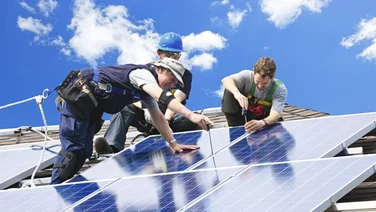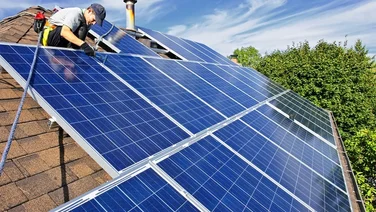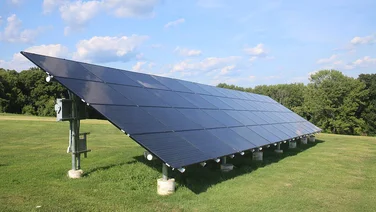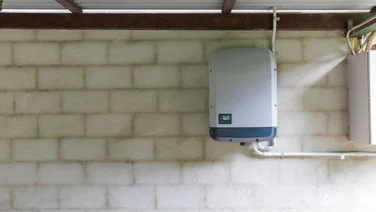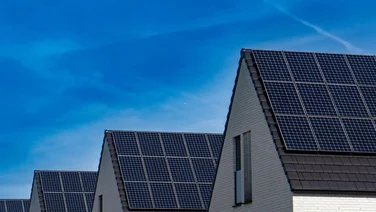- How do bifacial solar panels work?
- Do bifacial solar panels generate more electricity than traditional solar panels?
- How are bifacial solar panels installed?
- Where should you install bifacial solar panels?
- How do I look after bifacial solar panels?
- Things to consider before buying bifacial solar panels
- Summary
- Bifacial solar panels generate power from both front and rear surfaces
- Studies suggest they generate as much as 45% more electricity than ‘monofacial’ panels
- They are more expensive than conventional panels

It’s no secret that solar panels can cut your energy bills, and with government grants for solar panels available it’s easier than ever. What you might not know is that bifacial solar panels can make far more electricity than normal solar panels, with some studies suggesting they can increase output by as much as 45%.
The technology used with bifacial solar panels is similar to regular solar panels, but the key difference is they generate power from both front and rear surfaces, helping you get even cheaper energy bills.
If you’re still on the fence about bifacial solar panels, we’ve put together this guide to walk you through what they are and how they can help you make larger savings.
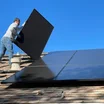
Thinking about solar panels?
Use the button below to get free, no obligation solar panel quotes from our trusted suppliers.
How do bifacial solar panels work?
Bifacial solar panels have a layer of protective glass on the front and a transparent polymer sheet on the back through which sunlight can pass through. They also have PV cells on the front and rear, allowing them to generate more energy than monofacial panels.
From here, the PV cells on the front will absorb light and generate power in the same way a monofacial panel does, but the difference is that the cells on the back of bifacial solar panels absorb light reflected on the ground, generating more electricity.
Finally, most bifacial solar panel designs also have dual glass at the rear, which means they can transmit light more efficiently and are also more resilient to the weather and moisture.
A bifacial solar panel is similar to a regular, or ‘monofacial’, solar panel, except that it generates electricity on both its front and rear surfaces.
While ‘monofacial’ is not a common name, we’ve used it throughout this guide to easily distinguish them from bifacial solar panels.
Do bifacial solar panels generate more electricity than traditional solar panels?
Yes, bifacial solar panels generate anywhere from 5%-45% more electricity per panel than conventional solar PV panels, according to a 2023 summary of 12 studies from Heriot-Watt University in Edinburgh.
A different study in India, also in 2023, narrowed that down to 31%-35% more electricity generated than a traditional solar panel.
How much money you’ll save depends on the size of the system, where and how it is installed, and the fluctuating cost of grid-supplied electricity over time.
The same is true for bifacial solar panels, perhaps more so as these units generate, relatively speaking, more electricity per panel (estimates are between 10-20% more) than conventional solar PV panels.
However, they are generally more expensive than monofacial solar panels, with upfront costs roughly between £4,000 to £12,000. What you pay will depend on the location, the size of your home and which system you choose.
According to WhatCost, a medium home of two-to-three bedrooms will need a 4kW system, which will cost anywhere from £5,500 and £6,600.
Like their monofacial counterparts, bifacial solar panels typically have a lifespan of at least 25 years. However, like any technology, this relies on proper maintenance and care over time.
One of the most popular questions we get asked is ‘how much are solar panels?‘ However, our page on solar panel costs should give you everything you need to know.

How are bifacial solar panels installed?
Install bifacial solar panels on a ground-mounted or elevated racking system so the backsheet can absorb light, and they tend to fall into two main types: vertical and horizontal.
But what does this mean specifically?
A vertical type involves installing the panels at an angle, enabling them to receive the maximum sunlight during the day. This method is typically reserved for ground-mounted PV farms or installations in open areas like fields.
A horizontal installation generally involves installing the panels at a flatter angle, with light reflected onto them by surfaces from gravel, sand, light stone or highly-reflected materials.
Sun tracking options can also be installed to boost the efficiency of PV installation as they can track (and change tilt angle) in response to the motion of the Sun throughout the day.
Jon Camp, former managing director of solar panel manufacturer RECOM Technologies said bifacial solar panels offer several advantages.
“Firstly, they can generate electricity from both sides, capturing sunlight reflected from the ground or surrounding surfaces,” Camp explained.
“This increased energy yield can result in higher overall power output compared to monofacial panels. Their versatility allows for installation in various orientations, maximising energy production in different environments”.
While possible, it is hard to make the most of bifacial solar panels if installed on roofs, so they aren’t strictly designed for residential buildings like monofacial panels.
According to Camp, installing bifacial solar panels on residential buildings can pose challenges due to the limited space and shading issues in urban environments.
“While it is possible to benefit from the extra power generation of bifacial panels on rooftops, proper planning and consideration are essential,” the company explained.
“With strategic placement and appropriate tilt angles, homeowners can still harness the advantages of bifacial panels on their rooftops”.
The company explained that bifacial solar panels are well-suited to environments with “ample space and reflective surfaces, such as industrial areas, open fields, or agricultural lands”.
Where should you install bifacial solar panels?
Like regular solar PV panels, bifacial panels can be installed in multiple places, but there are few things to think about before you get to do so.
These include height, reflectivity, and anything around that might get in the way, or cause shading.
Because they can generate electricity from both sides, bifacial solar panels are ideal for flat roofs and large utility space, such as industrial parks and farms.
Reducing your reliance on the National Grid can be beneficial, regardless of which solar panels you install, but before making your choice, you should consider the following:
- Cost – Bifacial solar panels are more expensive than standard solar panels. As a rule of thumb, they are typically around 10% more than conventional solar panels. More specifically, a domestic solar panel PV installation is around £7,500 on average, as of May 2025, so a typical bifacial solar panel installation should be around the £10,000 mark.
- Power – Bifacial solar panels typically produce between 10-30% more electricity than conventional solar panels. This means you get more electrical generation due to the amount of space the panels occupy.
- Maintenance – Bifacial solar panels are typically more robust and durable than monofacial solar panels. This is because both sides of the panels are covered with tempered glass, which is weather resistant. For this reason, bifacial solar panels require relatively less maintenance than conventional solar panels. Manufacturers typically give them a 25-year lifetime warranty, but some also offer 30-years.
How do I look after bifacial solar panels?
To ensure your bifacial solar panels last as long as possible, you’ll want to make sure you’re doing the following:
- Use a trained professional – Make sure you constantly hire the services of a trained professional to inspect and service your solar panels and ancillary equipment regularly. Just like other things in your home, like your boiler, this will significantly extend the life of the panels and may be a condition of the warranty, too.
- Clean them regularly – This keeps their surfaces free of dirt and grime, enabling as much sunlight as possible to reach the solar cells. Also, when cleaning them, make sure this is when they are cold to reduce the risk of damaging them from things like thermal stress.
- Inspect them regularly – If any is found, get a professional to make the necessary repairs.
- Look for condensation – Another often overlooked consideration with solar panels is shading. This is when something casts a shadow or otherwise impedes sunlight hitting a solar panel’s surface. Tree branches and surrounding buildings can reduce the power output of solar panels, so think carefully about where you choose to install them.
Things to consider before buying bifacial solar panels
Make sure to shop around for the best deal, but also, the right installer for you. The best deal will be a combination of price, the building you want to install the panels on and how much sunlight they’ll receive.
If you’re wondering ‘how much are solar panels?‘ check out our dedicated costs page.
You also want to consider the company you choose. Look at reviews, customer recommendations or even recommendations from neighbours, friends or families. You can also ask questions, get quotes and make a decision from there.
The advice from RECOM Technologies is to first assess space and surroundings to make sure the bifacial solar panels will get enough sunlight. This includes potential shading issues and how to maximise energy production.
“It’s crucial to consider the cost-effectiveness of bifacial panels compared to monofacial options and inquire about warranties and product reliability,” the company said.
We’ve covered some of the main things you need to know about bifacial panels above, but you should try to find models that offer the best of the following attributes:
- Efficiency
- Durability
- Cost
- Manufacturer (currently limited choice in the UK)
- Warranty (longer the better)
- Monocrystalline or polycrystalline (the former is more expensive but more efficient)
Summary
- Bifacial panels are dual-faced, meaning you get more bang for your buck when installed.
- They could potentially generate as much as 45% more electricity than conventional solar panels.
- These panels also tend to last longer, with expected lifespans of 30 or more years.
- They are more expensive, but the higher efficiencies offset the additional cost handsomely.
- They are relatively uncommon in the UK, so you’ll want to do more research to find the best fit for you.


